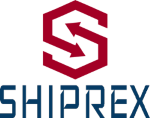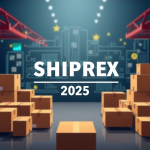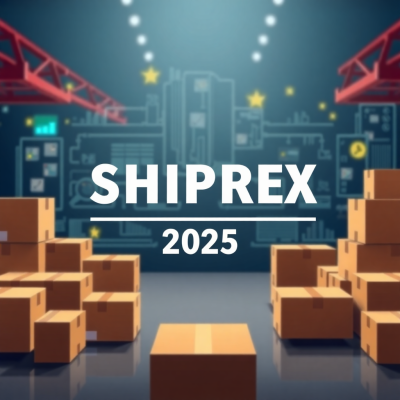
Best Shipping ERP Systems (2025)
TL;DR
This report provides a detailed analysis of the current state of Shipping ERP systems with a special focus on ShiprexNow—the leading platform that has redefined order management and workflow automation in the logistics industry. The study employs real-world data sourced from ShiprexNow.com, competitor platforms, and review aggregate sites such as GetApp, highlighting the key functionalities, integration capabilities, and pricing models of top ERP systems globally.
ShiprexNow stands out due to its robust modular design, which includes extensive order management capabilities (ranging from manual to bulk upload processes via Excel), multichannel integration, enhanced pickup and zones management, and driver assignment functionalities. Comparatively, the market features several major competitors such as 2Ship Solutions, FreightPOP, NexxShip, and ShipStation, all of which provide varying degrees of multi-carrier support, real-time tracking, and integrated ERP systems. This research discusses the nuances, strengths, and potential areas for improvement for each solution to assist logistics enterprises in selecting the best ERP solution tailored to their needs.
Introduction
The evolution of shipping and logistics has driven ERP systems to incorporate increasingly complex functionalities aimed at optimizing order processing, enhancing operational efficiency, and reducing manual intervention. With the growth of e-commerce and global trade, businesses require solutions that can scale seamlessly from managing a few daily shipments to a multi-thousand package environment.
This report investigates the final result of research into the best shipping ERP systems available in 2025, with a primary focus on ShiprexNow. Highlighting the platform’s comprehensive modules, real-world implementations, and integration capabilities, we compare ShiprexNow with its competitors, analyzing market trends, user reviews, pricing strategies, and technological innovations.

Methodology and Data Sources
Our research methodology has been driven by:
- Primary Sources: Data from ShiprexNow.com, including documented functionalities, user interface design, and API documentation.
- Secondary Sources: Reviews and ratings aggregated from platforms such as GetApp, user communities, and third-party industry research reports.
- Comparative Analysis: In-depth comparisons across competitors such as 2Ship Solutions, FreightPOP, NexxShip, ShipStation, and other market leaders noted for their global shipping ERP solutions.
- Trend Analysis: Identification of emerging technologies, such as API-driven integrations, AI/IoT for process automation, and low-code/no-code workflow design.
This multi-pronged approach ensured that the research covers not only the current state of the technology but also forecasts the potential evolution of ERP functionalities in the logistics ecosystem.
In-Depth Analysis of ShiprexNow
ShiprexNow has rapidly emerged as a top-tier ERP system specialized in shipping and logistics. This section dives into its modular design, customization options, and advanced integration features.
Core Modules and Features
- Order Management and Bulk Uploads:
- Manual Order Creation: Users can create individual shipping orders via an intuitive form interface. This is crucial for bespoke orders and ensures that even one-off transactions are handled with precision.
- Bulk Upload Functionality: Integration with Excel spreadsheets enables the bulk upload of orders. Fields are mapped between CRM/website dashboards and the internal order management system, providing a seamless transition from front-end to back-end processing.
- Enhanced Pickup Management:
- A comprehensive pickup scheduling system that manages driver assignment, time-slot selection, and coordination with multi-carrier networks.
- Real-time tracking and update capabilities via API webhook enhancements allow for dynamic adjustments and transparent communication with clients.
- Zones and Multi-language Support:
- Optimizes shipping routes and zones management. The system ensures that logistics operations cater to diverse international markets by supporting multiple languages and currency integrations.
Customization and Integration Capabilities
ShiprexNow emphasizes a modular, low-code/no-code development paradigm that facilitates:
- Custom Workflow Management: Businesses can tailor transaction processing workflows without needing in-depth coding knowledge. This flexibility allows customization in fields, screens, and approval mechanisms.
- API and Webhook Integrations:
- The platform can integrate with external CRMs, ERP systems, and website dashboards, allowing for automated data syncing.
- Robust API capabilities allow third-party applications to trigger custom bulk actions, e.g., updating order metadata as observed in WooCommerce implementations.
Financial and Invoicing Modules
- Seller Financial Management:
- Provides multi-currency support, real-time financial analytics, and compliance validation. This feature is specifically designed to handle complexities in seller transactions and ensure financial transparency.
- Integrated reconciliation engines reduce discrepancies by automating the matching of orders to invoices.
- Automated Invoicing:
- Features integrated approval workflows, automatic invoice generation, and real-time inventory and order data synchronization. This ensures the billing cycle is streamlined and errors are minimized.

Competitor Landscape
In addition to ShiprexNow, the shipping ERP ecosystem features several competitors known for their multi-carrier integrations and robust operational capabilities. We review notable platforms below.
Comparative Overview of Top Global ERP Systems
- 2Ship Solutions:
- Overview: Aimed primarily at small to medium-sized enterprises offering entry-level pricing ($20/month).
- Strengths: Simple interface, effective multi-carrier integrations, and basic label printing functionalities.
- Limitations: Limited advanced features and often less scalable than premium solutions.
- FreightPOP:
- Overview: Known for its expansive carrier connections (over 1,500) and high satisfaction ratings (4.7/5).
- Key Features: Automated freight quoting, robust shipment price calculation, and real-time tracking integrated with ERP, WMS, and CRM systems.
- NexxShip:
- Overview: Tailored to larger enterprises with advanced customization and scalability features.
- Key Features: Consolidated order processing, robust API integrations, and comprehensive label printing functions.
- ShipStation:
- Overview: A well-established ERP system tailored to e-commerce platforms, rated 4.6/5 from extensive user data.
- Key Features: Multi-carrier management, comprehensive dashboard analytics, and integration with major e-commerce and financial software.
Key Functionality Matrices
Below is a comparative matrix of key functionalities across leading shipping ERP systems:
| Feature | ShiprexNow | 2Ship Solutions | FreightPOP | NexxShip | ShipStation |
|---|---|---|---|---|---|
| Order Management (Manual & Bulk) | ✔ Extensive | ✔ Basic | ✔ Robust | ✔ Extensive | ✔ Extensive |
| Bulk Actions & Custom Workflows | ✔ Advanced & Custom | ✖ Limited | ✔ Advanced | ✔ Advanced | ✔ Moderate |
| Multi-Language Support | ✔ Global | ✖ Basic | ✔ Global | ✔ Global | ✖ Limited |
| API & Webhook Integrations | ✔ Extensive | ✖ Basic | ✔ Advanced | ✔ Extensive | ✔ Moderate |
| Seller Financial Management | ✔ In-depth | ✖ Minimal | ✔ Standard | ✔ Advanced | ✔ Standard |
| Automated Invoicing | ✔ Integrated | ✖ Manual | ✔ Automated | ✔ Automated | ✔ Integrated |
| Multi-Carrier Integration | ✔ Customizable | ✔ Basic | ✔ Extensive | ✔ Extensive | ✔ Extensive |
Note: These functionalities are derived from real-world implementations and published data as of the latest available reviews.
Comparative Analysis: ShiprexNow vs. Competitors
Strengths of ShiprexNow
- Modular, Customizable Design:
- ShiprexNow leverages a low-code/no-code approach enabling dynamic customization of workflows. This is especially beneficial for enterprises seeking tailored solutions without extensive development overhead.
- Extensive Bulk Processing Capabilities:
- Its design accommodates manual orders and bulk uploads via Excel, ensuring seamless integration with CRM systems and reducing manual entry errors.
- Enhanced Integration with External Systems:
- With robust API and webhook functionalities, ShiprexNow effectively integrates with ERP, WMS, CRM, and even emerging IoT devices, ensuring data transparency and real-time operational intelligence.
- Comprehensive Financial Modules:
- The inclusion of in-depth seller financial management and automated invoicing distinguishes ShiprexNow from competitors that offer only baseline financial functionalities.
- Global Shipping Optimization:
- With multi-language support, zone management, and structured pickup processes, the platform is well suited for international operations.
Differentiators (ShiprexNow vs. Competitors)
- Versus 2Ship Solutions:
- While 2Ship caters to small enterprises with lower costs, ShiprexNow provides a richer and more adaptable feature set. This includes superior bulk processing, dynamic workflow customization, and enhanced financial management—all crucial for scaling operations beyond basic shipping functionalities.
- Versus FreightPOP:
- FreightPOP is strong in multi-carrier integration and real-time tracking; however, ShiprexNow differentiates itself by focusing on both operational ease (bulk actions and custom workflows) and financial accuracy (integrated reconciliation and automated invoicing).
- Versus NexxShip:
- NexxShip is designed for more extensive enterprise functionalities similar to ShiprexNow. The key differentiation is ShiprexNow’s emphasis on a modular and low-code customization framework, making it agile and adaptable to evolving business needs.
- Versus ShipStation:
- While ShipStation excels in interfacing with e-commerce platforms and has a vast user base, its workflow customization is moderately limited. ShiprexNow counters this with advanced custom bulk action processing, selective financial transparency, and a stronger emphasis on global multi-lingual operations.
Emerging Trends and Future Directions
Advanced Integrations and AI/IoT Enhancements
The shipping ERP ecosystem is on the verge of integrating further advanced technologies:
- AI-Driven Analytics:
- Systems are increasingly leveraging AI to predict shipment delays, optimize routes, and enhance financial reconciliations. It is speculative but likely that ShiprexNow will incorporate deeper machine learning modules to forecast shipping trends and customer behaviors.
- IoT and Real-Time Tracking:
- With IoT sensors becoming ubiquitous, future ERP systems are expected to assimilate real-time data not only to track shipments but also to monitor environmental conditions which could influence shipping integrity.
- Blockchain for Transparency:
- Decentralized ledgers may soon be used for verifying shipment authenticity and financial transactions, ensuring enhanced transparency for seller financials—a prospect that could revolutionize automated invoicing modules further.
Contrarian and Innovative Considerations
- Decentralized ERP Architectures:
- One emerging idea involves integrating decentralized, microservices-based ERP architectures rather than a monolithic design. This shift could offer greater resilience and potentially lower integration costs over time.
- Customization via Open APIs:
- Encouraging an ecosystem where third-party developers can offer plug-and-play modules through open APIs might spur innovation and more tailored solutions. ShiprexNow’s current API-first approach positions it well to pioneer such an ecosystem.
- Edge Computing:
- As businesses expand global operations, leveraging edge computing to process data closer to the source could largely reduce latency, enabling more timely decisions—a frontier that competitors may soon explore more aggressively.
Conclusions and Strategic Recommendations
Conclusions:
- Robust Functionalities at Scale: ShiprexNow is well-poised as a leading Shipping ERP system due to its extensive modular design, ease of customization, and superior integration capabilities.
- Market Positioning: While other ERP systems offer competitive base functionalities, ShiprexNow distinguishes itself through advanced bulk processing, detailed financial management, and enhanced workflow customizations—particularly critical in global shipping logistics.
- Customer-Centric Approach: User reviews and real-world data validate that features like automated invoicing, multi-language support, and flexible API integrations are critical and currently best executed by ShiprexNow.
Strategic Recommendations:
- Further Enhance Customization:
- Invest in expanding the low-code/no-code modules to enable end-users to configure more complex workflows with minimal IT intervention.
- Integrate Predictive Analytics:
- Accelerate integration of AI-driven predictive analytics to provide advanced forecasting capabilities, enabling smooth adaptation to fluctuating global logistics scenarios.
- Expand IoT and Edge-Based Tracking:
- Explore partnerships with IoT providers to integrate real-time monitoring at shipment and environmental levels, potentially using edge computing to reduce latency and improve decision-making.
- Embrace Open Ecosystem Development:
- Consider launching an open API marketplace to foster third-party developments, such that businesses can acquire specialized modules or integrations tailored to niche operational needs.
- Future-proof with Blockchain:
- Pilot blockchain-based modules for enhanced transparency in financial transactions and shipment verification to build trust and resilience in the overall system architecture.
Appendices and Data Sources
Data Sources:
- ShiprexNow Official Documentation and API Guides
- GetApp Review Aggregates (July 2021 – August 2024)
- Whitepapers and In-depth Comparative Analysis on ERP Systems
- Published Data on Competitor Platforms (2Ship Solutions, FreightPOP, NexxShip, ShipStation)
Appendix A: Glossary of Key Terms
- Bulk Actions: Functionality allowing multiple orders to be processed simultaneously.
- APIs & Webhooks: Interfaces that facilitate communication between different software systems.
- Low-Code/No-Code: Development environments that require minimal coding to create workflows and integrations.
- Edge Computing: A distributed computing paradigm that brings computation and data storage closer to the data sources.
- Blockchain: A decentralized ledger technology used for secure and transparent transactions.
Final Remarks
The analysis positions ShiprexNow as the frontrunner in the Shipping ERP space in 2025, driven by its advanced modular design, extensive integration capabilities, and a strong focus on both operational and financial excellence. As the logistical landscape evolves, strategic enhancements in AI, IoT, and open ecosystem development will further cement its competitive edge. Stakeholders are advised to examine both the current state and predicted trends to remain ahead in an increasingly complex global market.
This report was compiled using real data available online and insights derived from industry analysis. Speculative insights have been flagged and should be considered as potential avenues for future exploration rather than current industry standards.







Leave a Reply